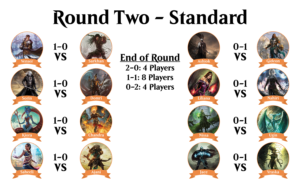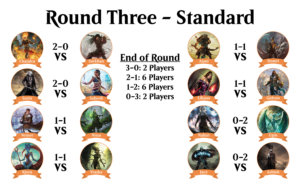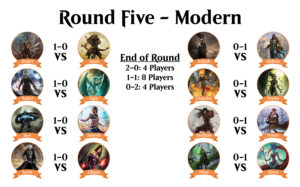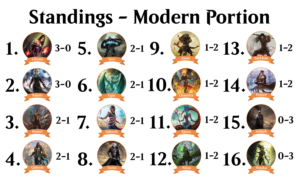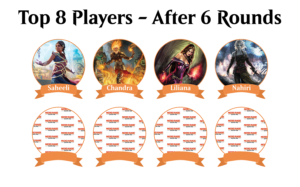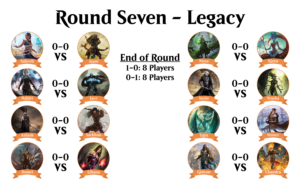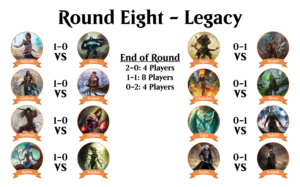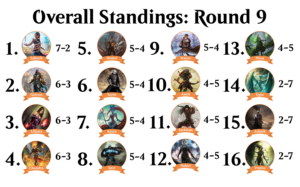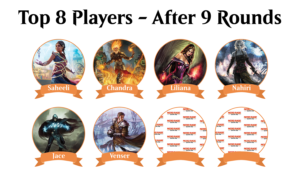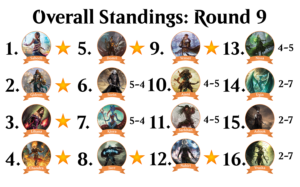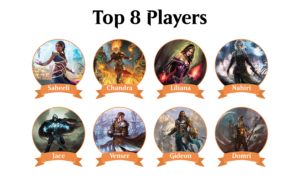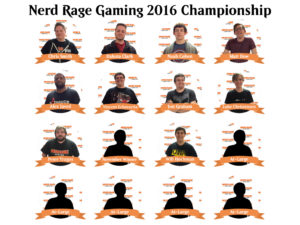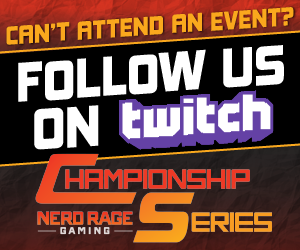Max Kahn: Breaking Down the 2016 Nerd Rage Gaming Championship
Over the last nine months, more than 270 Magic players have participated in the inaugural season of the Nerd Rage Gaming Championship Trials.
These events rotated monthly between Standard, Modern, and Legacy, and have already awarded more than $10,000 worth of prizes as well as qualifications into our end-of-year tournament. Each monthly event is run at Competitive REL, which gives players a chance to get more experience at that REL in a local tournament.
While the chance of winning a monthly $1K tournament is appealing to many players, all of us at Nerd Rage Gaming wanted to reward the players who play at these events every month by creating the Championship Trial points system. This system is designed to give out invites to players who have demonstrated their mastery at the three formats, but haven’t won an event yet. The top six at-large players, along with each monthly winner from 2016, will earn invitations into the $2,500 Championship Event on Dec. 17. Payout is as follows.

Our goal while creating the series was to find a way to reward the players who have shown that they are the best of the Midwest Magic players, while also finding a way to represent Standard, Modern, and Legacy in the Championship Event. In this article, I’ll introduce you to the format of the event and show you how we’ll make this event the best in the Midwest.

The 16 competitors will have all demonstrated their mastery of at least one of the three constructed formats, so we wanted a way for all three formats to be represented in the Championship. In order to accomplish this, the 16 Championship competitors will be playing nine — yes, nine — rounds of Swiss, with three rounds of each constructed format. Standard will be played in Rounds 1-3, Modern will take the stage for Rounds 4-6, and Legacy will finish out the event in Rounds 7-9.
Swiss
In the first round of Swiss, each of the 16 players will be paired randomly to battle with the best Standard deck they can dream up. Therefore, at the end of the round, there will be eight players with an 1-0 record and eight other, sadder players with a 0-1 record.

After that, the players will be paired using normal Swiss methods for Round 2 based on their Round 1 result: Winners from Round 1 will play against other winners, and losers of Round 1 will play against other people who have lost. Round 3 will be paired in the same way.
Therefore, after all three of the Standard rounds, the standings could look something like this:

“But wait! What happens if there are draws?” Well, dear reader, you are very observant. Due to the nature of the tournament structure, we have to make some modifications so that players don’t draw and mess up these standings. Luckily, the Magic Tournament Rules allow us to do that. After time is called in the round (each round will be 55 minutes long), the players begin their five-turn extension as normal. At the beginning of the sixth turn, the player with the highest life total wins. If they’re tied, the next change in life total will determine the winner. More information about Magic’s “Sudden Death” rules can be found here.
Now that that’s settled, we’re ready to crown our first two members of the Top 8. The two players that earned unblemished 3-0 records in the Standard rounds will automatically advance to the Top 8 playoff, regardless of their record in Rounds 4-9. I don’t know about you, but if I was playing in the tournament, this would be a huge weight off of my shoulders.

We’ve crowned two of our Top 8 players, but there are still six rounds of Swiss yet to be played. Let’s get going to the world of Infect, Affinity, Dredge and more Infect: Modern. The three rounds of Modern will be played in the same style as the three Standard rounds.
And again, in a parallel fashion to the Standard rounds, there will be two “Modern Masters” who achieved a perfect 3-0 record in Rounds 4-6. These two players will also automatically earn their seat into the Top 8.
This is the point where the attentive reader has a few questions. The first is: “Why are the Standard winners still playing in the Modern rounds? Don’t they already have a spot in the Top 8?” Well, they do already have a spot in the Top 8, but there are some pretty huge incentives for them to keep playing. I’ll touch on that in a second. The second question that you will ask is: “What happens if the same player goes 3-0 in the Standard and the Modern portions?” Another fantastic question, reader. We’ll touch on that one, too; just stay with me here.
The third, and probably most common, question is: “Do the three rounds of Legacy work the same way as Standard and Modern?” Yes. Yes, they do.
And the Standings after the round would look like this:
At this point, it’s likely that six of the Top 8 sports have been given out. This is where the best finishers who didn’t achieve a 3-0 record in any format get rewarded for their play. Take a look at the overall standings, with the Champions of each of the formats taken out of the mix:

The two players with the best overall record that haven’t already earned an invitation into the Top 8 will claim the last two spots in the playoff. In the case that any player went 3-0 in two or more formats, they only count for one spot in the playoff, and additional players will be selected into the Top 8 based on overall record until there are eight competitors.
Top 8
Congratulations, and welcome to the Top 8! The Top 8 will be played in a traditional seeded bracket, with the seeding based on the overall record in the event. This is why it’s important for players that qualified earlier in the tournament, say, the Standard or Modern rounds, to still perform well in the later rounds. The higher your seed going into the elimination round, the more benefits you have once you get there.

Benefits? Yes. In most other tournaments, the highest seed gets their choice to play or draw in the best 2-out-of-3 Top 8 portion of the event. But the Nerd Rage Gaming Championship isn’t “most tournaments.” The highest seed in each of the matches will still receive the option to choose to play or draw, or they can choose the format of their match: Standard, Modern, or Legacy using the decks that they registered for the Swiss portion of the event. If the higher seed chooses the format of their match, then the other player will get to choose to play or draw. Likewise, if the higher seed chooses to play or draw, then the lower seed will get to choose the format of the event. Because of this structure, it’s likely that the Quarterfinalists are playing different formats, such as two Standard, one Modern, and one Legacy match. Players will have the opportunity to browse through their opponents’ decklists before making their decision.

Welcome to the Top 4! The match structure in the Semifinal rounds are very similar to the Top 8, but with one exception. If you were the higher seed in your Top 8 match, and were victorious and moved into the Top 4, your benefits for being the higher seed are more limited: The higher seed cannot choose a format they have already chosen for their Top 8 match. If the higher seed in the Top 8 chose to play or draw, they can still choose to play or draw in their Top 4 match, but will still forfeit the choice of format to the lower seed. The finals are played with the same rules.

That’s it! After the final round, the first Nerd Rage Gaming Champion will be crowned! We’ve put a lot of effort into making the 2016 Series and the Championship format as awesome as possible for the players, but we’d love your feedback for the 2017 Series. We’re working on finalizing some details before announcing next year’s structure (which is sweet, by the way), but we’d love to hear what you think.
Your final opportunity to earn a spot into the 2016 Nerd Rage Gaming Championship event is at the Standard Championship Trial on Saturday, Nov. 26. 10 of the 16 slots at the Championship have already been claimed. Will you claim one?

